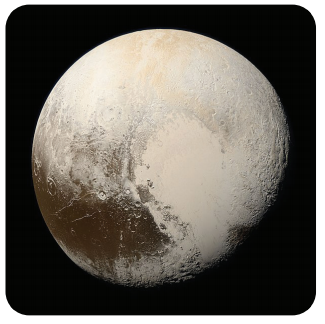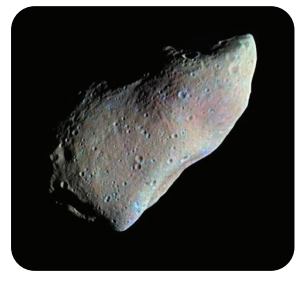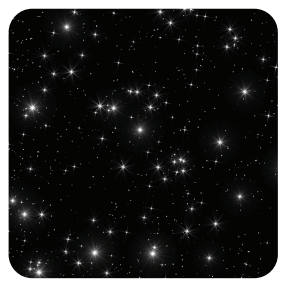Small Bodies of the Solar System
Definition
A small body in the solar system is a small object on an orbiting trajectory around the Sun that does not meet the criteria for classification as planets, dwarf planets, or moons (natural satellites). This term was first defined in Prague on August 24, 2006 at XXVI. General Assembly of the International Astronomical Union, which addressed the issue of the inclusion of the dwarf planet Pluto and the definition of the term planet. Therefore, we include among the small bodies of the solar system: all comets and minor planets, which are not dwarf planets at the same time. This may change over time, depending on how the International Astronomical Union will add new objects to the category of dwarf planets from the ranks of the minor planets, so it is always necessary to find out current information, e.g. on the web site Astronomy – astronomy.zcu.cz –– Planets – Small Bodies.
Comets
A comet is a small body in the solar system composed mainly of ice and dust. It orbits the Sun mostly along a very elongated trajectory. Comets have a striking tail as they approach the Sun. The substances that sublimate the comet's coma and tail are dry ice (CO2) and ice (H2O). For sublimation to occur, the comet must get closer to the Sun than the distance of Jupiter. The comets that are permanently in this area have already lost all their ice and dry ice. Therefore, the tail can only form in comets that get close to the Sun from great distances. The comet loses many tons of material when flying around the Sun. Only a grey and black coating of dust particles and pieces of rock will remain on its surface. Sublimation then takes place only from deep vents during the next flight. Therefore, comets are likened by astronomers to very dirty snowballs. The tail of comets can also have unimaginable dimensions comparable to the distance of the Earth from the Sun, i. e. 1 au ~ 150 million km.

Fig. 1: Comet Hale-Bopp with a white dust and blue gaseous tail
(source: https://commons.wikimedia.org/wiki/File:Halebopp031197.jpg

Fig. 2: The elongated trajectory of the comet, indicating the direction of the dusty and gaseous tail, is not in the correct scale of size and distance
(source: https://commons.wikimedia.org/wiki/File:Cometorbit.sk.png)
Comets are classified according to their orbital periods into short-period and long-period comets. Short-period comets have an orbital period of less than 200 years, while long-period comets have a longer orbital period, but still remain gravitationally dependent on the Sun. The Kuiper belt is generally considered to be the site of formation of short-period comets. Long-period comets probably form in the Oort cloud.

Fig. 3: The surface of comet 67P / Churyumov – Gerasimenko from a height of 10 km captured by the Philae landing module, which was part of the Rosetta spacecraft (source: https://commons.wikimedia.org/wiki/File:NAVCAM_top_10_at_10_km_%E2%80%93_8_
(15765234852).jpg)
Minor Planets
A minor planet is a small body orbiting the Sun, due to its small mass, mostly irregular in shape. Bodies larger than 100 m are usually considered to be minor planets. The smaller ones are called meteoroids. Minor planets are sometimes also referred to as asteroids. This designation is older and incorrect because it is based on the Greek word aster, star. The suffix -oid means similar.

Fig. 4: Minor planet (951) Gaspra in a photograph taken by Galileo spacecraft in 1991 from a distance of 5300 km
(zdroj: https://commons.wikimedia.org/wiki/File:Galileo_Gaspra_Mosaic.jpg)
The first minor planet was discovered on January 1, 1801 at the Palermo Observatory by Giuseppe Piazza and was named Ceres. Now, this object is included in the category of dwarf planets. Minor planets were once considered planets. Over time, however, it was discovered that these bodies are very small (compared to the dimensions of known planets), they began to be called in British English “minor planets”. The term minor planet expresses the essence of these objects and not how they appear when viewed through a telescope. The term asteroid is still used, especially in American terminology, and is maintained in other languages through translations.

Fig. 5: Schematic representation of the main belt of minor planets between the orbits of Mars and Jupiter. The minor planets of the group of Jupiter Trojans that precede and follow Jupiter on its orbital trajectory are shown.
(source: https://commons.wikimedia.org/wiki/File:Asteroid_Belt-cs.jpg)
The largest concentration (in the order of hundreds of thousands) of known minor planets in the solar system is located in the main belt of minor planets between the trajectories of Mars and Jupiter. A large number of minor planets are also located in the Kuiper belt behind the trajectory of Neptune, we call these minor planets trans-Neptunian objects (TNO), but only a few thousand are catalogued, because it is difficult to discover these objects due to their small size and huge distance from Earth. Of course, there are exceptions, in the vicinity of large gaseous planets (especially Jupiter) there is a significant (in the order of thousands) number of minor planets, which we call the Trojans. These minor planets have the same orbital period as the influencing planet and are concentrated on the orbiting trajectory of the planet around points that precede or follow the planet by 60°.
One of the largest minor planets and at the same time the brightest in the sky is called (4) Vesta. It was discovered in 1807 as the 4th minor planet in a row and has a diameter of 525 km. The smallest planets are several meters in size and were objects that approached a distance smaller than the Moon's trajectory. Objects that occur regularly near the Earth are collectively called Near Earth Objects (NEOs). A specific issue is how to search for minor planets. It is impossible to find them in one single image. It is possible to see this in the picture, it is practically impossible to mark objects that are minor planets in this picture.

Fig. 6: Image of a starry sky
In order to identify a minor planet in the image, it is necessary to capture its movement. There are two ways to achieve this. Either expose some part of the sky long enough (tens of minutes to hours depending on the planet's distance from the Earth) to show the planet's own motion against a fixed stellar background, which appears as a line in the image, or obtain at least two separate images with a short exposure time with sufficient time lag. The second method is more preferred and used more often because it allows more accurate measurement of parameters.
Asteroids
Recently, there has been great interest in identifying minor planets that intersect the Earth's orbital trajectory and by which there is therefore a risk of collision with the Earth. These objects are called Potentially Hazardous Asteroids (PHA). We will classify the minor planet as potentially dangerous if the shortest distance of its orbital trajectory from the orbital trajectory of the Earth is less than 0.05 au (approximately 7.5 million km) and its diameter is greater than 150 m. An object of this size will no longer be captured by the Earth's atmosphere and can cause a complete devastation of large areas (after impact on land) or a devastating tsunami (after impact on the ocean). A minor planet of this size collides with the Earth on average once every 10,000 years. The Turin or Palermo scales are used to categorise the hazards of potentially dangerous asteroids. It turns out that the extinction at the end of the Cretaceous Period 66 million years ago probably caused the impact of the minor planet Chicxulub in the area of the current Gulf of Mexico. It collided with the Earth at a speed of about 20 km/s.


